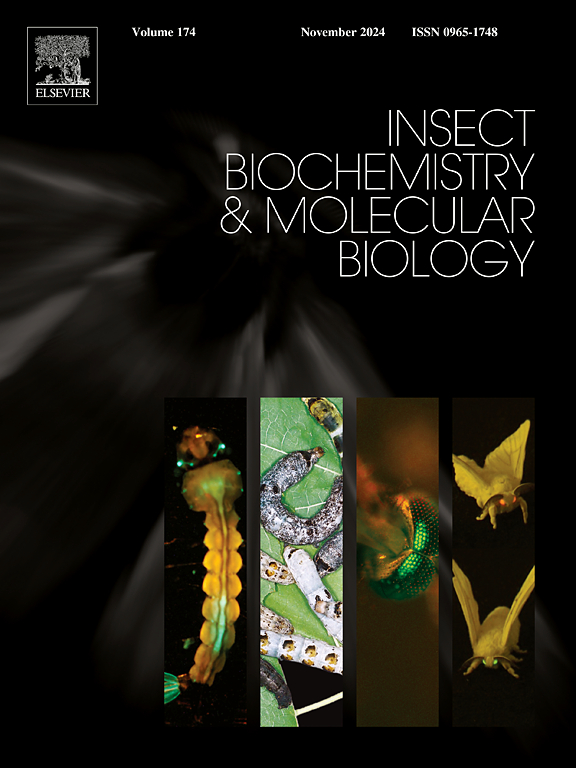Identification of biliverdin as a pigment involved in the seasonal variation of green lacewing body colour and the enzymes involved in its metabolism
IF 3.7
2区 农林科学
Q2 BIOCHEMISTRY & MOLECULAR BIOLOGY
引用次数: 0
Abstract
The green lacewing, Chrysoperla nipponensis, is an insect that undergoes complete metamorphosis, and its body colour changes depending on the developmental stage; adults and larvae are greenish and brownish, respectively. In addition, the body colour of some adults changes to brown in winter, suggesting that environmental factors influence pigment biosynthesis in this insect. However, the underlying colour regulation systems remain unknown. In this study, we purified the pigments that produce the body colour of green adult lacewings and identified biliverdin via MS/MS analyses. We therefore elucidated the mRNA and amino acid sequences of biliverdin-related biosynthetic enzymes, such as haem oxygenase (HO) and biliverdin reductase (BR), in C. nipponensis. By expressing recombinant BR in E. coli, we investigated the ability of BR to metabolize biliverdin. In addition, via RNAi techniques, we examined whether the suppression of these enzymes changed body colour. Finally, we quantified the expression levels of the mRNAs encoding these enzymes and compared those in green adults reared under normal conditions with those in brown adults reared under winter-mimicking conditions. The results suggest that not only biliverdin but also other green pigments contribute to the green body colour of adult lacewings.

绿草体色季节变化中胆绿素及其代谢酶的鉴定。
绿草蛉(Chrysoperla nipponensis)是一种经历完全变态的昆虫,其身体颜色随发育阶段而变化;成虫和幼虫分别呈绿色和棕色。此外,一些成虫的身体颜色在冬季变成棕色,表明环境因素影响了这种昆虫色素的生物合成。然而,潜在的颜色调节系统仍然未知。本研究纯化了绿草蛉成虫产生体色的色素,并通过质谱联用分析鉴定了胆绿素。因此,我们明确了日本月子中与胆绿素相关的血红素加氧酶(HO)和胆绿素还原酶(BR)的mRNA和氨基酸序列。通过在大肠杆菌中表达重组BR,我们研究了BR代谢胆绿素的能力。此外,通过RNAi技术,我们检测了这些酶的抑制是否会改变体色。最后,我们量化了编码这些酶的mrna的表达水平,并比较了在正常条件下饲养的绿色成虫和在模拟冬季条件下饲养的棕色成虫的表达水平。结果表明,除胆绿素外,其他绿色色素对草蛉成虫的绿色体色也有一定的作用。
本文章由计算机程序翻译,如有差异,请以英文原文为准。
求助全文
约1分钟内获得全文
求助全文
来源期刊
CiteScore
7.40
自引率
5.30%
发文量
105
审稿时长
40 days
期刊介绍:
This international journal publishes original contributions and mini-reviews in the fields of insect biochemistry and insect molecular biology. Main areas of interest are neurochemistry, hormone and pheromone biochemistry, enzymes and metabolism, hormone action and gene regulation, gene characterization and structure, pharmacology, immunology and cell and tissue culture. Papers on the biochemistry and molecular biology of other groups of arthropods are published if of general interest to the readership. Technique papers will be considered for publication if they significantly advance the field of insect biochemistry and molecular biology in the opinion of the Editors and Editorial Board.

 求助内容:
求助内容: 应助结果提醒方式:
应助结果提醒方式:


